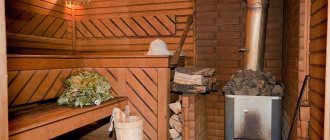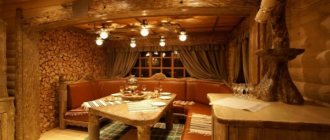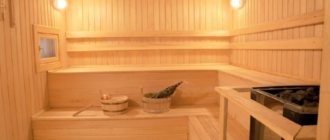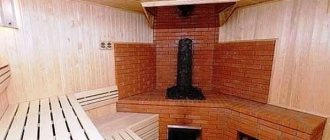- Posted by Svetlana
- Date: September 1, 2014
After the construction of the bathhouse is completed, you should think about the interior decoration. This is perhaps the most important work, since it includes heat, hydro and vapor barrier, which will ensure the proper functioning of the building. It is the interior decoration that determines how cozy your bathhouse will be and how pleasantly you will spend time in it.
It is very important to consider step by step each element of the work on the internal arrangement of the bathhouse in general and the steam room in particular. Any mistake at this stage may result in inconveniences in the future that will be very difficult to correct.
- 2 Preliminary preparation
- 3 More about skin layers
- 4 Install a heat and vapor barrier layer
- 5 Internal lining of the steam room
- 6 Video about the interior decoration of the bathhouse
Requirements for insulation of a bath room
The most important quality of a steam room is the preservation of hot steam and heat inside the room for a long time. That is why thermal insulation comes first in finishing. There are many methods for such work, but we will consider the simplest and most common ones, which can be easily done with your own hands, without the help of specialists.
When choosing materials for insulation, you should be guided by their safety at the usual high temperatures for a steam room, that is, fire resistance and resistance to sudden temperature changes . The most common materials are mineral wool as insulation and aluminum foil as a vapor barrier. They are highly reliable and easy to operate.
Before you begin work on insulating the walls of the bathhouse, you should carefully prepare the surfaces. Carefully examine the walls and ceiling, remove gaps, knots, and roughness. All wooden surfaces are treated with an antiseptic, which will provide protection against fungus and mold.
By insulating and equipping a bathhouse, you will get walls in the form of a so-called “sandwich”, consisting of layers alternating in a certain sequence: a waterproofing layer, an insulating layer, a vapor barrier, and, finally, an internal lining.
What to make a bath floor from
Floor in the bathhouse
Floors in the steam room can be made of concrete, clay and even ordinary earth. Floors must be arranged so that water quickly leaves the bath area. To avoid the risk of heat stroke, concrete or clay floors are covered with mats or planks. Cork covering is also perfect.
If you decide to finish the floor with tiles, you must first build a screed and carefully level the floor surface. The tiles are glued with a special mixture. The seams between the products are filled with waterproof grout. It will not allow water to pass under the tile layer and will not allow fungus or mold to grow there. The tiles are covered with a wooden grid on top to prevent feet from slipping and people from falling.
We recommend: Do-it-yourself installation of suspended ceilings
Another floor can be made from sanded boards. This flooring makes the atmosphere in the bathhouse more comfortable and cozy.
Preliminary preparation
As you know, the main thing in a Russian bath is a properly installed stove. It must be built before you begin interior decoration. And in this case, it is better to seek the help of a professional stove maker, who will determine where the hearth should be, set the correct direction of the outlets and build the body.
Installing a traditional brick or stone stove will require special attention to such features as the soil on which the bathhouse is built, the foundation, the materials used in the construction of the walls, the type of roof, and even the climatic conditions of the area. To make your task much easier, you can turn to modern technologies. In construction markets and in specialized stores there is a huge selection of boilers and stoves, which in their functionality are in no way inferior to a classic stone sauna stove, but compared to it, they are completely safe, and also economical and easy to use.
Such a heating device will not require any special skills from you; you can install it yourself, or with the help of a specialist, quite quickly and without subsequent removal of accumulated construction waste . Manufacturers provide customers with a complete set of necessary equipment and additional devices.
After the stove is installed, install the electrical wiring, provide its insulation and the necessary terminals, and then proceed directly to the interior decoration.
More about skin layers
Insulation of the walls of a bathhouse, and especially a steam room, should begin with a layer that provides waterproofing. It will help avoid condensation on external walls when in contact with hot air and constant temperature changes. Particular attention should be paid to any possibility of dampness affecting the walls: the occurrence of mold and mildew not only has a detrimental effect on wooden surfaces, including rotting, but can also have a harmful effect on your health.
The materials most commonly used as a waterproofing material are foil or polyethylene film. You should pull evenly measured parts of the material from the roll, leaving allowances of about 10-15 cm, carefully stretch the film or sheet of foil to avoid tears and damage, and secure them using a construction stapler. At the junction of individual sheets there should be an overlap of 10-15 cm, which will not allow moisture from the outside to enter the gap and settle on the insulation layer.
After the waterproofing of the walls, floor and ceiling is completed and all possible gaps have been sealed, proceed to install the insulating layer. To begin with, sheets of clean, thoroughly dried paper are attached to the surface. To minimize the loss of hot air, the sheets should be fastened with a sufficiently large overlap.
After this, a pre-fabricated frame is installed on the insulated surface. For it you will need wooden blocks with a cross section of 50 X 50 mm, properly impregnated with an antiseptic. The width of the step between the beams must exactly match the width of the roll of material that is used.
A few words about the choice of thermal insulation material. In the modern construction and repair market you can find a lot of options of different properties, quality and price category. But still the most common and in demand is mineral wool. Synthetic soft slabs are also gaining popularity. These inorganic materials are durable, fire-resistant, are not subject to moisture absorption and subsequent rotting, and are also not of interest to small rodents and insects.
Selection of materials
To the question “How to decorate the inside of the bathhouse?” we can answer unequivocally that the most suitable material is lining - special panels for wall cladding, the main advantages of which include:
- good microcirculation, allowing the walls to breathe
- no condensation
- pleasing to the eye appearance
- ease of installation
- reasonable cost
the best source material for making lining, since walls made of them allow the room to quickly warm up, while at the same time remaining comfortable for humans in temperature.
This type of material does not emit resinous substances when heated and therefore will not cause harm to health.
Of the listed species, the most preferred (and not only for wall cladding) is larch, but it is also the most expensive material.
It is advisable to first treat linden lining with a special composition (of course, from natural ingredients) in order to preserve its original - almost white - color.
Due to its hardness, aspen lining is also a good cladding material, but experts prefer to use it for ceilings and walls .
durable and resistant to decay , and with its beautiful core you can achieve an attractive decorative effect.
Alder, which has a strong, even structure and a pleasant light brown color with a peculiar pink tint, can be a worthy material for finishing ( especially inside a bathhouse made of foam blocks ).
It is not recommended to use birch as a starting material for lining because of its loose structure and susceptibility to drying out during preparation.
If, for some reason, you still have to make lining from this rock, then you must take into account that it has a loose structure and will be subject to drying out .
A relatively new material, which professionals recommend using to cover walls in a steam room, is lining made from African oak Abash (or Abashi).
This coating has a number of valuable properties , thanks to which this material is considered almost ideal:
- low level of thermal conductivity;
- lightness and at the same time strength;
- resistance to deformation, absence of cracks and chips when sawing and drilling;
- resistance to rotting;
- the presence of a unique, beautiful pattern on the surface.
This material has only one drawback - its rather high cost . But it is covered by the properties mentioned above.
Whatever the source material the lining is made from, it must first be well dried and processed so that there are no roughnesses on it.
We install a heat and vapor barrier layer
The thickness of the layer of heat-insulating material directly depends on the design of the insulated surface. It should be noted that the floor of the bathhouse, both wooden and concrete, is insulated using a certain technology, and this work is labor-intensive enough to devote a separate article to it. Now we are considering the insulation of the walls and ceiling of a traditional wooden bathhouse.
The ceiling is subject to much more thorough insulation than the walls, so the layer of mineral wool on it should be twice as thick. This is due to the fact that the hot air in the steam room rises, and it is through the ceiling that maximum heat loss occurs.
So, the frame previously made from beams is installed on the surface and carefully secured with screws or bushings. An even piece of insulating material is placed in the space between the beams. It should lie tightly, without free spaces or overlaps. The edges of the material are secured using a construction stapler.
Once the installation of mineral wool is complete, it’s time for the next stage – vapor barrier. Aluminum foil is most often used in this capacity, since it not only protects the insulation from steam and moisture, but also has reflective properties. Thanks to this quality, foil creates the so-called “thermos effect” in the steam room, retaining heat inside the room for a long time.
So, to install the vapor barrier layer you will need:
- Aluminum foil in the required quantity;
- Thin slats for sheathing;
- Small wallpaper nails or a construction stapler;
- Scotch tape or adhesive tape.
For vapor barrier, it is preferable to take foil with a thickness of 65 microns. This is a material that is optimal in density and strength and is easy to work with.
First of all, you should prepare the sheathing. Since the room of the bathhouse and steam room is small, it will be easy to make the lathing by stuffing slats to the frame of the heat-insulating layer.
After this, sheets of foil are secured to the sheathing using wallpaper nails or a stapler. At the same time, they should be well, but not too tightly, and carefully aligned. The overlap of the sheets on each other should not be more than 5 cm. Since the vapor barrier layer must be continuous, the sheets are connected with tape at all joints.
The main condition for the materials used: they must be environmentally friendly, and when exposed to heat and moisture they must not emit foreign odors of a chemical nature. This is why such common building materials as roofing felt, roofing felt or glassine are not used in the interior decoration of bathhouses.
Finishing around the stove
The space around the stove needs special finishing for the reason that the proximity of the hot stove to the flammable material of the walls (the same lining) can lead to a fire.
Fireproof board for finishing walls when installing a sauna stove
Therefore, a heat-insulating material, for example, mineralite or superizol (mounting on ceramic bushings is desirable). A stainless steel sheet can be attached to reflect heat.
Tiles near the stove
If the walls are not made of wood, you can protect them with heat-resistant tiles. Since tiles are used for lining stoves and fireplaces, you can find many varieties on sale, from which the seller will select the right one for you.
Of course, stove tiles are more than suitable for wall decoration, but they can be more expensive, so it’s worth measuring the heating temperature of an object located at the same distance that will separate your stove from the wall.
ATTENTION! Glazed tiles are not useful here either, because glass cannot withstand high temperatures. If you take tiles, then only matte ones.
And one more thing - you need to take into account the fact that in bathhouses on a personal plot in winter, if not used for a long time, the temperature can be below zero.
Some types of tiles are not intended for sudden changes in temperature when heating a bath - this issue should also be clarified with the seller. If you choose the wrong tile, it will crumble.
Steam room interior lining
After the “sandwich” of hydro-, heat- and vapor barrier is ready, we will proceed to the final stage - cladding the walls and ceiling in the room using lining. Traditionally, natural wood is chosen for cladding, mainly hardwood, such as linden, maple, aspen and alder. These materials are optimal in quality, properties, and besides, their price is low. Softwood boards can release resin when exposed to heat, which is unpleasant for the skin. If, after all, the pine aroma in a bathhouse is very important to you, then choose cedar. It has high density and low resinity.
When choosing material for lining, adhere to the following requirements:
- The high density of wood will provide resistance to high humidity and protection from rotting;
- The lowest content or complete absence of resins;
- The surface of the board must be absolutely smooth, without gaps or knots;
- The wood should have low thermal conductivity, that is, it should not heat up too much so as not to cause burns on the skin.
On the installed vapor barrier layer, install a frame made of bars, which will hold the lining on itself. After this, hammer the boards one by one, carefully adjusting them using a wooden hammer. For fastening, you can use nails or self-tapping screws, the main condition is that the caps must be buried in the surface, so that later lovers of bath procedures do not get hurt in the process.
Typically, the location of the lining during cladding is horizontal or vertical. The vertical method is simpler and can be used in any direction. When using the horizontal method, the lining should be filled from the bottom up to prevent water from getting into the joints and grooves.
Most often, the lining is fastened flush. To do this, grooves are cut on each board and overlap each other. This will provide a tighter fit, which means protection from moisture and temperature changes for the insulation layers and the inner surface of the lining.
Features of the steam room construction
When arranging a steam room with your own hands, you need to adhere to a number of rules.
Selection of oven
The main parameters on which the operation of the furnace will depend are: the number of stones and the duration of their heating, the power consumption of the furnace, the grate material, the heat resistance of the body and the design of the unit. To provide heat, in addition to the steam room, the adjacent rooms with their total area of 24 square meters require a power of 25 kW. Building a stove with your own hands will provide an opportunity to save costs on the overall construction of a bathhouse.
Floor finishing
As a material for flooring, the best solution is to use natural stone or porcelain tiles. For safe movement, plank flooring is laid. There is absolutely no need to insulate the floor. Moreover, one of the requirements for the arrangement of the floor is the creation of a hole for water outlet. Wood as a material for flooring is not a good option, since high humidity will lead to its deformation and rapid failure.
Ceiling finishing
For a ceiling, a height of about 2200 cm is sufficient; this is explained by human physiology and the physical properties of steam. With ceiling sizes that exceed this value, steam will escape upward and the effect of its action will simply be lost. Reducing the height will lead to discomfort during bath procedures, since there is a risk of head injury and difficulties arise when working with a broom.
Doors and windows
Installing windows is not considered a requirement. Glass or wood will be the most optimal material option for constructing doors.
- A glass door is practical.
- A wooden door is a tradition.
Determining the correct location of the furnace and choosing a steam source
Important factors when choosing a stove are the size of the steam room, the energy source and the method of generating steam.
A heater is a traditional solution when choosing a stove for a sauna. Stones are placed inside this oven. The traditional fuel is wood, but gas or electricity can be used. Furnaces can be of several types.
- On wood. The installation of this stove in the bathhouse can provide a unique atmosphere. Even the fact that this stove will need to be periodically cleaned to remove soot from the stones will not overshadow the pleasure of taking a bath procedure. In order to reduce the appearance of soot, it is necessary to use aspen firewood as fuel. To maintain a stable temperature, you need to constantly monitor the combustion process.
- Gas. The use of a gas oven is characterized by good maintenance of the required temperature in the steam room, excellent heating speed and ease of operation. A significant disadvantage of this device is the size of the furnace and its large demand for gas. Using a furnace of this type is not advisable when there is no connection to the central gas line.
- Electric. The heater, which runs on electricity, is quite easy to use. This electrical appliance makes it possible to quickly achieve the required temperature, has sufficient power and is compact. Its arrangement does not require the organization of a chimney. The electric heater is safe for humans and the environment; due to the use of automation, its maintenance is simplified as much as possible, and its design features prevent the possibility of injury. The main disadvantage of this device is its high electricity consumption.
Types of heaters
The heater can be closed or open. If several people plan to visit the sauna at the same time, then the best choice is an open type of heater. The firebox (the place where the fuel burns) is not equipped with fire-resistant masonry. It is the place where stones are placed. This stove device allows the stones to heat up and warm up all the rooms of the bathhouse. When exposed to water, heaters with this device quickly lose temperature. This design is used in electric furnaces.
A closed stove is considered a traditional option for arranging a bathhouse. In this case, a large number of stones are placed in a special place in the furnace. In this case, steam is released through a special door; its level is opposite the stones in the first row. During fuel combustion, this door must be closed. To heat the steam room, open it in advance.











